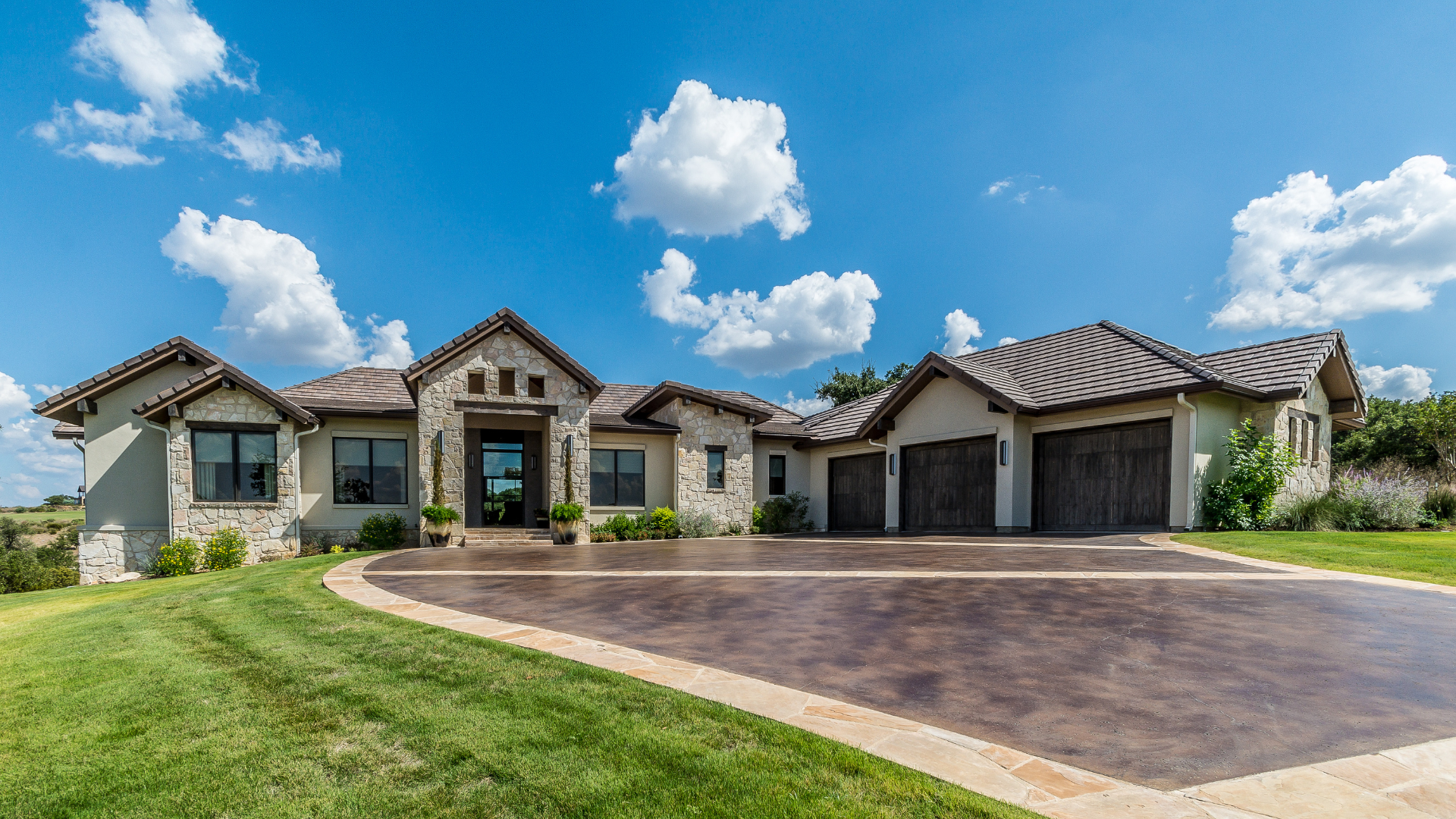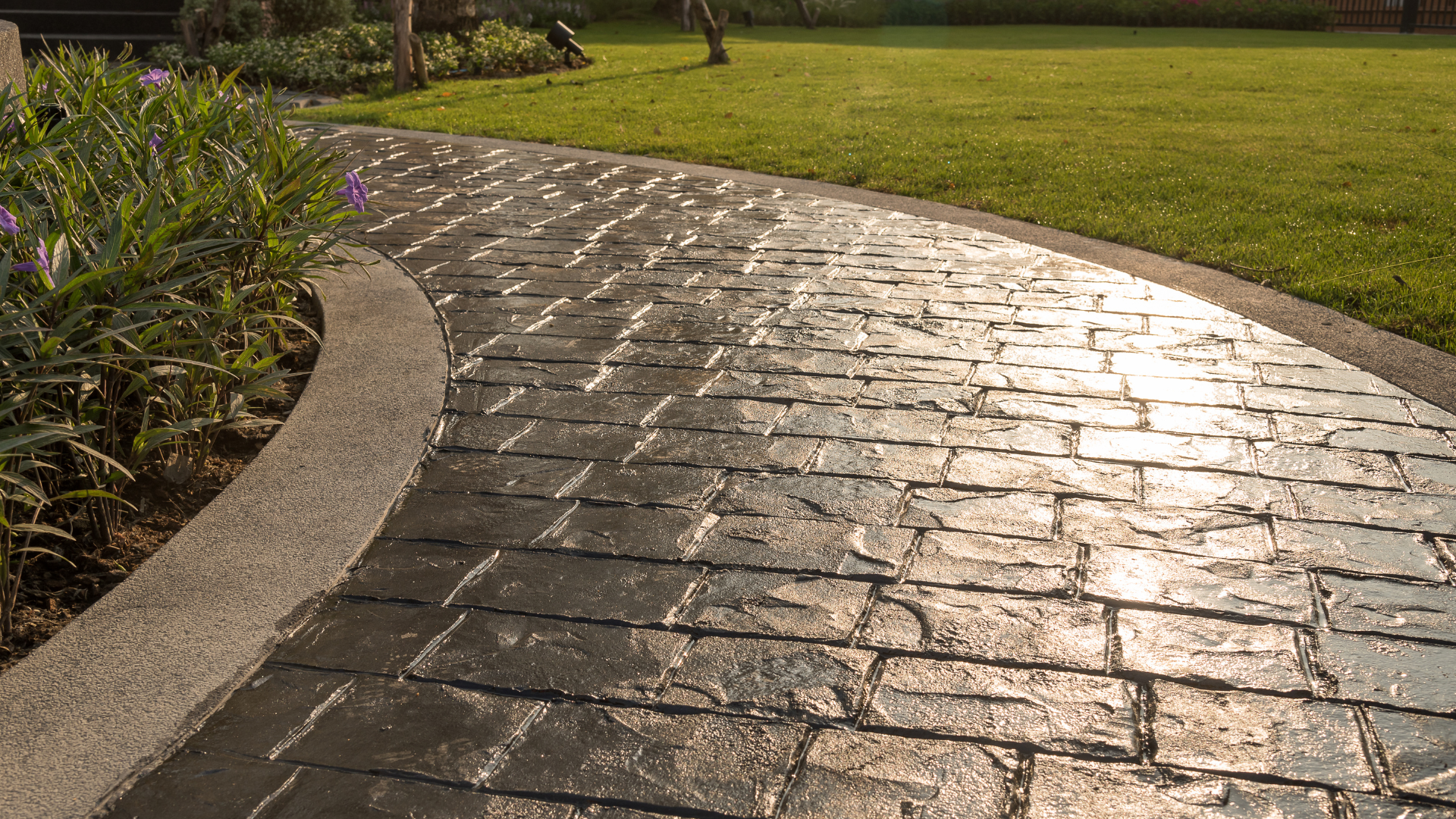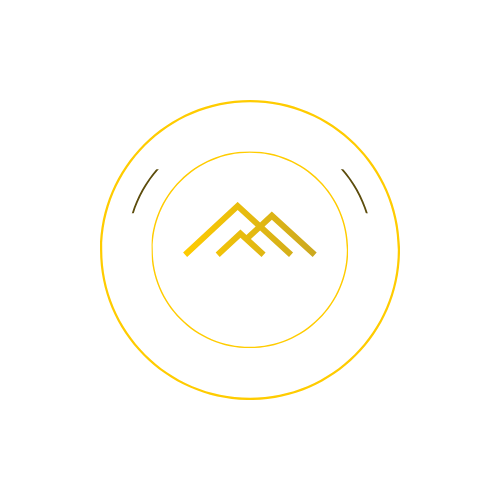Guide to Decorative Concrete: Unleash Its Beauty
What is Decorative Concrete?
When people think of concrete, they often imagine a dull, gray surface. However, decorative concrete is far from that! Decorative concrete is a specialized form of concrete that uses various techniques to enhance its aesthetic appearance.
It involves adding color, texture, and design elements to the surface of the concrete to give it a unique and visually appealing look. The purpose of decorative concrete is to provide an alternative to traditional flooring materials such as wood or stone.
It offers homeowners and businesses an affordable way to create beautiful surfaces that are durable, low-maintenance, and long-lasting. Whether it's for outdoor patios or indoor floors, decorative concrete provides endless design possibilities.
A Brief History of Decorative Concrete
Decorative concrete has been around for centuries but only gained popularity in recent decades due to technological advancements and creative innovations in the industry. The ancient Romans were among the first civilizations to experiment with decorative concrete by using different aggregates and pigments in their mixture. In the early 1900s, stamped concrete was introduced as a way to mimic natural stone patterns on walkways and patios.
In the 1950s-60s colored aggregate was introduced which allowed designers more control over color variations than ever before. Nowadays new techniques such as polished or stained finish have brought about more modern looks while still utilizing basic principles established centuries ago.
With each passing year new trends are becoming popular like exposed aggregate finishes that enhance natural beauty within poured slabs while adding durability. : Despite being around for ages, decorative forms of this long-standing building-material continue growing into new areas with each passing year thanks largely due technological advances allowing designers more freedom than ever before!
Types of Decorative Concrete
Decorative concrete is a versatile material that can be customized in many ways. There are several types of decorative concrete, including stamped, stained, and polished. In this section, we will explore each type in detail.
Stamped Concrete
Stamped concrete is created by pressing a pattern into freshly poured concrete before it sets. The pattern can be made to look like natural stones such as slate or flagstone, or it can be a unique geometric design. This type of decorative concrete is popular for outdoor patios and walkways because it provides a durable and slip-resistant surface.
The process of creating stamped concrete involves several steps. First, the area to be stamped must be prepared by clearing debris and leveling the ground.
Then the concrete is poured and smoothed out before the stamping process begins. A special mat with the desired pattern is pressed into the wet concrete while it's still pliable.
Design options for stamped concrete are endless! You can choose from patterns that mimic natural stone or custom designs like company logos or family crests.
Stained Concrete
Stained concrete is another type of decorative option for creating unique surfaces. Stains come in a variety of colors which allows for endless possibilities when designing your space; from earth tones to bright hues.
The staining process begins after the concrete has been poured and cured to ensure proper adherence to the surface. Acid-based stains penetrate into the pores of the material creating an organic look that varies from piece to piece giving you a one-of-a-kind result with every application.
One advantage is its ability to create intricate designs: think murals on floors or table tops! With stained surfaces you have full control over how much color saturation you want while still being able to see through parts where there isn't stain applied.
Polished Concrete
Polished decorative cement is a perfect way to create a sleek and elegant surface. While not as popular as other decorative concrete options, polished surfaces have become increasingly trendy in recent years.
Polishing concrete involves using special machinery with diamond discs of varying grits that gradually remove the top layer of the material to create a smooth and shiny finish. Polished concrete is often used for indoor flooring because it's easy to clean, resistant to scratches and stains, as well as long-lasting.
There are numerous finishes available when polishing concrete; From satin finish to high-gloss shine, you can customize your floors according to your style preference. You can even choose between different levels of aggregate exposure or colorization for a more unique look.
Choosing decorative concrete allows you much more flexibility compared with traditional building materials such as wood or stone. With stamped patterns that simulate natural materials, stained designs that mimic organic shapes and textures all while having the ability to select custom stain colors or polished finishes - there's an endless number of ways in which you can create unique surfaces!
Design Options for Decorative Concrete
Decorative concrete is a versatile material that can be customized to suit a wide range of design preferences. Whether you prefer modern or rustic styles, there are several design options available for decorative concrete.
Patterns
One of the most popular design options for decorative concrete is patterns. Patterns can be used to create geometric shapes, natural stone patterns, or even brick patterns. Geometric shapes such as triangles and squares are often used in modern designs and provide a clean and sleek look.
Natural stone patterns such as slate or flagstone can create a rustic and earthy feel. Brick patterns are also commonly used to create a traditional look.
The process of creating patterns in decorative concrete is done through stamping or etching that replicates the pattern you desire onto your chosen surface. This allows you to have intricate designs on your floor without the added expense of using actual stones or bricks.
Colors
The color options available for decorative concrete are extensive, ranging from earth tones like brown and beige to bright colors like reds and blues. The coloring materials used for staining the concrete come in powder form or liquid form that penetrates into the porous material allowing it have long-lasting color. The color choice will depend on what aesthetic appeal you would like your surface to have while considering how it pairs with other design elements around it such as furniture, wall paint or fixtures.
Textures
Textures can greatly enhance the look of decorative concrete by adding dimension and depth to the surface area. Smooth finishes create an elegant aesthetic perfect for outdoor pool decks where people may walk barefooted; whereas rough finishes add an interesting texture that works well with outdoor patios areas..
You can achieve varied texture levels when creating decorative concrete by adding sand, aggregates or pebbles to the concrete mix. This results in a surface that is slip-resistant and improves safety especially in areas that are often wet like pool decks or patios.
With so many design options available for decorative concrete, you can easily create a surface area that is exclusively yours. Whether you prefer a modern look with geometric shapes and bright colors or something more traditional with natural stone textures and earth tones, there's a design option for everyone.
Applications of Decorative Concrete
Outdoor Patios and Walkways: Finding the Perfect Design
Decorative concrete is a popular option for outdoor patios and walkways due to its durability, versatility, and ability to mimic the natural look of stone. With decorative concrete, homeowners can choose from a variety of design options that will enhance the beauty of their backyard. One popular design trend is using stamped concrete to create eye-catching patterns that resemble natural stone or brick.
The pattern options are endless, from cobblestone to flagstone. Another option is using stained concrete to add color and character to your outdoor space.
There are numerous colors available for staining concrete; ranging from earth tones such as brown and gray to vibrant shades like blue and red. You can even mix colors together for a unique effect.
In addition, incorporating textures into your patio or walkway can add depth and interest to an otherwise ordinary surface. A smooth finish creates a modern feel while rough finishes give off more of a rustic vibe.
Indoor Flooring: How Decorative Concrete Can Transform Your Home
Decorative concrete isn't just for outdoor use - it's also an excellent choice for indoor flooring! Decorative concrete floors offer homeowners many benefits over traditional flooring materials such as carpet or hardwood floors.
When it comes to indoor flooring options with decorative concrete, it's all about textures and finishes! The polished finish option provides a sleek appearance that will make your space look more modern than ever before!
Many people love how polished surfaces reflect light which makes rooms appear brighter! Another great option is stained concrete which gives you endless possibilities in terms of color choices.
You can have fun choosing different colors that match your home decor theme perfectly! Stained floors work well in living rooms, dining areas or recreational spaces!
If you really want something unique with an industrial feel textured finishes may be the perfect option for you! Textured floors mimic the look of natural stone or rustic materials which looks fantastic in many types of homes.
Pool Decks: Making a Splash with Decorative Concrete
Decorative concrete is not only beautiful but also practical when it comes to designing your pool deck. This material can withstand harsh weather conditions that come with outdoor living spaces.
With stamped concrete patterns homeowners can pick from a range of designs such as brick, stone or wood looks to create an elegant and durable surface around their pool area. Additionally, incorporating colors into your design like blues and greens can give your backyard oasis a serene and calming feel.
Using textured finishes for your pool deck's surfaces provides safety by making them slip-resistant! This is important, especially for families with young children or elderly members who may be more prone to slipping.
Decorative concrete is an excellent choice for outdoor patios and walkways, indoor flooring solutions, and pool decks. With its versatility in colors, patterns, textures and finishes; decorative concrete allows homeowners to fully customize their home's appearance while being practical at the same time!
Maintenance of Decorative Concrete
Cleaning techniques
One of the biggest benefits of decorative concrete is its low-maintenance nature. Cleaning your decorative concrete is simple and easy to do.
Start by sweeping or blowing away any loose debris like dirt, leaves, or small stones from the surface. Then, use a hose to wet down the surface and apply a mild detergent.
You can use a stiff-bristled brush to scrub away any stubborn stains or dirt marks. Rinse the surface with clean water and let it dry completely.
You can also use a pressure washer to clean your decorative concrete, but make sure to adjust the pressure so that it doesn't damage the surface. A pressure washer is especially useful for cleaning areas with lots of tough stains and grime build-up.
Sealing recommendations
To maintain the beauty and longevity of your decorative concrete, it's important to seal it regularly. Sealing helps protect against moisture penetration, staining, and wear-and-tear.
The recommended type of sealer will depend on the specific type of decorative concrete you have installed. For stamped concrete surfaces, use an acrylic-based sealer that will help preserve color consistency while providing protection against heavy traffic, UV rays, and other environmental factors.
For stained concrete surfaces, choose a penetrating sealer that will protect from moisture penetration while allowing for proper breathability. Polished concrete should be sealed using a densifier or penetrating sealer that will increase its durability and resistance against staining agents like oil spills.
In general, reseal your decorative concrete every 1-3 years depending on its exposure to weather elements and traffic. Overall maintenance for Decorative Concrete
Decorative Concrete requires less maintenance than other materials used in construction but still needs adequate care to ensure its longevity. In addition to regular cleaning and sealing practices outlined above there are few more things you can do to keep your concrete in the best condition possible.
First, avoid using abrasive cleaning products, such as steel wool or scrub brushes with wire bristles, which can scratch or damage the surface. Second, be aware of what you place on top of your decorative concrete.
Heavy furniture or sharp objects can cause denting and chipping. It's important to address any repairs promptly before they turn into bigger issues.
Cracks and chips in the surface should be repaired as soon as possible to prevent moisture from seeping into the substrate and causing further damage. By properly maintaining your decorative concrete surfaces, you will keep them looking their best for years to come.
Advantages of Using Decorative Concrete
Cost-effective alternative to traditional materials such as wood or stone
One of the significant advantages of using decorative concrete is its cost-effectiveness. When compared to traditional materials like wood and stone, decorative concrete is much more affordable.
This makes it an attractive option for homeowners who want to enhance their outdoor or indoor living spaces with a beautiful and durable material without breaking the bank. Additionally, because decorative concrete can mimic the look and feel of natural materials, it's an excellent option for those who want the aesthetic appeal without sacrificing their budget.
Another benefit of decorative concrete's affordability is that it allows homeowners to use it in larger areas without worrying about cost constraints. This means that you can extend your outdoor entertainment space by adding a decorative concrete patio or pool deck while still having some money left over to invest in other home improvement projects.
Durable and long-lasting material that can withstand harsh weather conditions
Decorative concrete is incredibly durable and long-lasting, making it an ideal choice for high traffic areas like driveways, walkways, and even commercial spaces. Because it's made from high-quality materials and undergoes a rigorous installation process, decorative concrete can withstand harsh weather conditions like heatwaves, snowstorms, heavy rainfalls, and even earthquakes.
Concrete has been used for centuries as a building material because of its strength and durability. With advances in technology today, modern concrete mixtures are even stronger than before.
Additionally, by using advanced sealing techniques on your decorative concrete surfaces periodically will keep them looking new for years to come. : because of its durability characteristics combined with sealing techniques available today make this investment one that will last you many years if not decades into the future.
Conclusion on Advantages of Using Decorative Concrete
There are numerous benefits associated with using decorative concrete. It's an affordable and durable material that is perfect for enhancing both indoor and outdoor living spaces.
Unlike traditional materials like wood and stone, decorative concrete can withstand harsh weather conditions, making it an excellent choice for areas with extreme weather patterns. Whether you're looking to transform your outdoor patio, pool deck or walkway or searching for a low-cost alternative to traditional flooring options, decorative concrete is the way to go.
It's affordable, durable, long-lasting, and available in various designs that will suit your tastes and preferences. Investing in decorative concrete will not only enhance your home's aesthetic appeal but also increase its overall value.
So why wait? Discover the beauty of decorative concrete today!
Conclusion on the Benefits of Using Decorative Concrete
Decorative concrete is a versatile and cost-effective alternative to traditional building materials such as wood or stone. It offers a wide range of designs and applications that can fit any specific need, from outdoor patios to indoor flooring. Its durability and long-lasting properties make it an ideal material for harsh weather conditions.
Aside from the aesthetic appeal, decorative concrete has several benefits that make it an excellent option for construction projects. One significant benefit is its low maintenance requirement, making it an efficient choice for homeowners or businesses looking to reduce upkeep costs.
Additionally, unlike wood or other organic materials, concrete does not attract pests like termites or carpenter ants. Another advantage of using decorative concrete is its eco-friendliness.
Many decorative concrete manufacturers use recycled materials in their products, reducing the overall amount of waste produced during construction projects. This makes decorative concrete a suitable choice for environmentally conscious consumers who wish to reduce their carbon footprint.
Choosing decorative concrete over traditional building materials has several benefits not only in terms of cost-effectiveness but also durability, versatility, and eco-friendliness. With a limitless array of design options available and its ability to withstand harsh weather conditions with minimal maintenance requirements, there's no denying that decorative concrete should be at the top of your list when considering building materials for your next project.
So why not choose the modern way? Choose decorative concrete!
You might also like
Schedule a Free Estimate Today!
We will get back to you as soon as possible
Please try again later



